1. Angels Landing, Utah
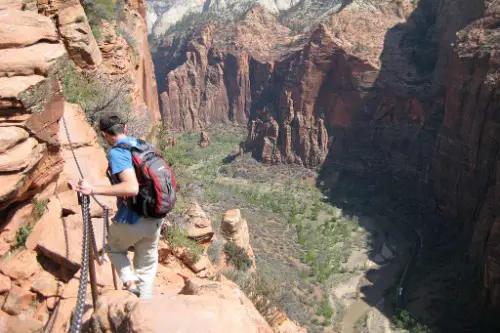
Angels Landing in Zion National Park is breathtaking—but it’s also terrifying. The trail’s most infamous section, a narrow ridge with sheer drop-offs on both sides, leaves little room for error. While chains are provided for support, the trail still sees its share of accidents, including fatalities, according to The US Sun. The climb to the summit involves steep switchbacks like Walter’s Wiggles, a series of 21 sharp turns that test even seasoned hikers. Those with a fear of heights might want to think twice before attempting this trail, as the final ascent demands nerves of steel and good balance.
What makes Angels Landing particularly hazardous is its popularity. The trail can get crowded, which increases the risk of accidental falls. Add to that the desert heat in the summer and icy conditions in the winter, and it’s clear why this trail is not for the faint of heart. In recent years, the park has implemented a permit system to control foot traffic, but even with fewer hikers, it remains a formidable challenge.
2. Bright Angel Trail, Arizona
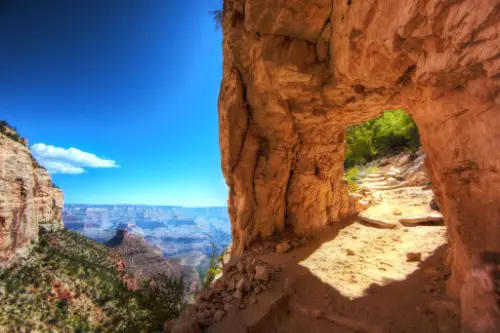
The Bright Angel Trail in Grand Canyon National Park might seem inviting, but it’s notorious for catching hikers off guard. Descending into the canyon is deceptively easy—coming back up is another story. With an elevation change of over 4,500 feet, this trail demands serious stamina. Hikers often underestimate the toll of heat, dehydration, and the steep climb, leading to numerous rescue missions every year, according to the National Park Service.
Temperature swings in the Grand Canyon can be extreme, with scorching heat at the bottom and much cooler temperatures at the rim. Many hikers also miscalculate the time it takes to complete the round trip, leading to dangerous situations as night falls. The trail does have rest houses and water stations, but they’re not enough to mitigate the risks for unprepared visitors.
3. Kalalau Trail, Hawaii
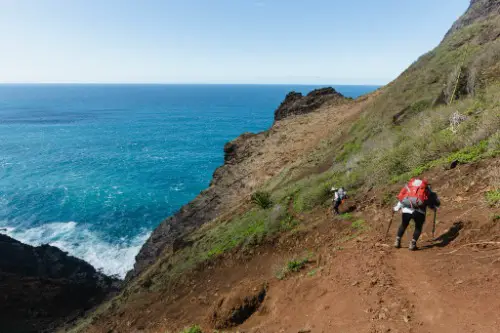
The Kalalau Trail on Kauai’s Na Pali Coast offers jaw-dropping views of the Pacific Ocean, but it comes at a price. This 11-mile trail features narrow pathways that hug cliffs, often without railings. The tropical weather can quickly turn sunny trails into slippery nightmares, with mudslides adding another layer of peril, according to GoKalalau. The infamous Hanakapiai Stream crossing has claimed lives during flash floods, making this trail particularly dangerous during the rainy season.
What makes Kalalau even more intimidating is its remote location. Emergency services are limited, and rescuers may take hours to reach hikers in trouble. For those who venture past Hanakapiai Beach, the trail becomes even more rugged and challenging. Despite its risks, the allure of Kalalau’s beauty continues to attract adventurous hikers, many of whom underestimate its dangers.
4. The Maze, Utah
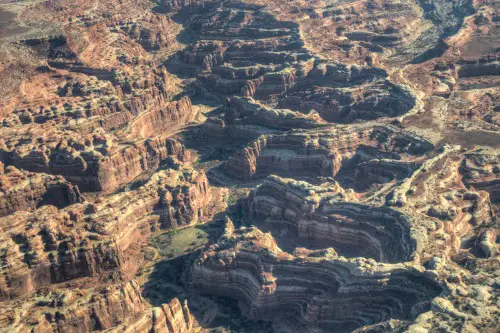
Located in Canyonlands National Park, The Maze is less of a trail and more of a labyrinthine adventure through remote desert terrain, CNN reports. This area is infamous for its confusing network of canyons, where even experienced hikers can lose their way. It’s one of the least accessible regions of the park, requiring hours of driving on rough roads just to reach the starting point. Once inside, the terrain is rugged, with steep drop-offs, unpredictable weather, and no marked trails.
The lack of water sources adds another layer of difficulty, as hikers must carry everything they’ll need for the trip. Cell service is nonexistent, and rescue efforts in The Maze are incredibly challenging due to its isolation. The Bureau of Land Management advises only highly experienced adventurers to attempt this trek.
5. Mount Washington, New Hampshire
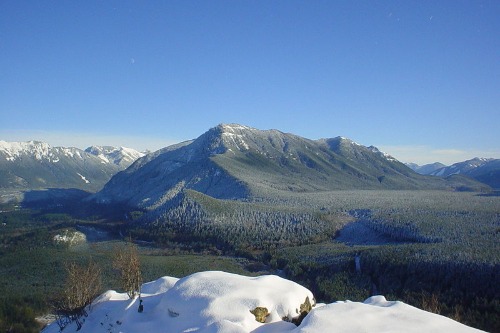
Mount Washington may not be the tallest mountain in the U.S., but it’s earned a reputation as one of the most dangerous due to its unpredictable weather. The summit holds the record for the fastest surface wind speed ever observed, at 231 mph. Hikers often face frigid temperatures, even in the summer, along with sudden storms that can turn a pleasant outing into a fight for survival.
The trails leading to the summit, such as Tuckerman Ravine, are steep and rocky, adding to the challenge. While the mountain does offer sweeping views of the surrounding White Mountains, it’s not uncommon for hikers to succumb to hypothermia or injuries from slips and falls, The Boston Globe warns. Preparedness is key, but even seasoned hikers have found themselves overwhelmed by Mount Washington’s fierce conditions.
6. Half Dome, California
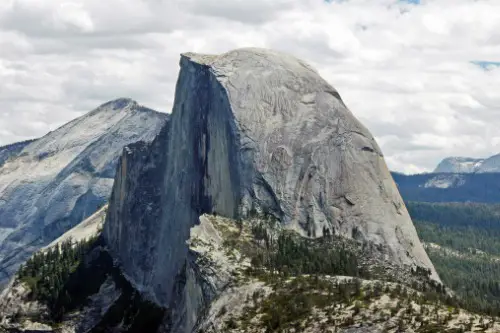
Half Dome in Yosemite National Park is a bucket-list hike for many, but it’s also one of the most dangerous. The final stretch involves a nearly vertical climb using cables bolted into the rock. This section is not only physically demanding but also terrifying for those with a fear of heights. Wet or slippery conditions can make the cables especially hazardous, and falls from this area are often fatal.
Permits are required to hike Half Dome, which has helped reduce overcrowding, but the trail still sees its share of accidents. The entire hike is a grueling 16 miles round trip with a 4,800-foot elevation gain, and many hikers underestimate the physical toll. Add in the potential for altitude sickness, dehydration, and afternoon thunderstorms, and it’s clear why Half Dome demands serious preparation.
7. Devil’s Path, New York
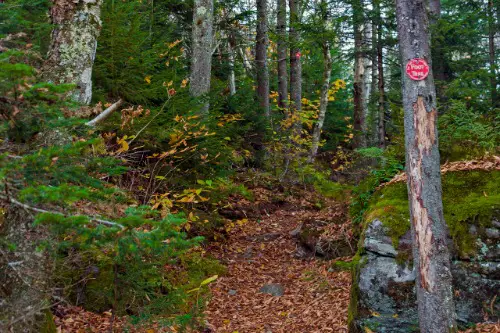
Despite its ominous name, Devil’s Path in the Catskills continues to lure thrill-seekers. This 25-mile trail features steep ascents, rocky scrambles, and dense forests that make navigation difficult. It’s not unusual for hikers to lose the trail, especially in poor weather or low light. The route also includes several challenging summits, each with its own set of hazards, such as loose rocks and slippery ledges.
Many hikers underestimate the time required to complete Devil’s Path, leading to risky situations as night falls. The trail’s remoteness means that rescues can take hours or even days, and cell service is unreliable at best. The combination of physical challenges and navigation difficulties makes this trail a true test of endurance and skill.
8. Mist Trail, California
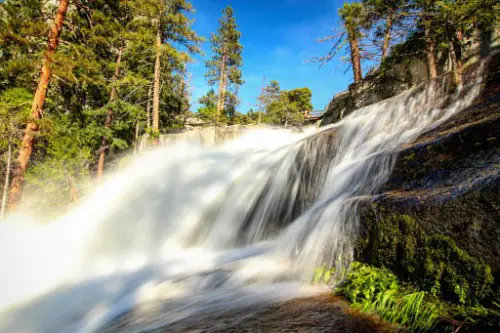
The Mist Trail in Yosemite National Park is one of the park’s most popular hikes, but it’s also deceptively dangerous. The trail climbs steeply alongside Vernal and Nevada Falls, where slippery granite steps and heavy mist create hazardous conditions. Many hikers have fallen into the Merced River after losing their footing, and swimming near the falls is strictly prohibited due to strong currents.
In addition to its slippery terrain, the Mist Trail can get incredibly crowded, increasing the risk of accidents. Afternoon thunderstorms and sudden temperature drops add to the danger, making preparation essential. While the views of the waterfalls are undeniably stunning, this trail demands caution and respect for its natural hazards.
9. Chilkoot Trail, Alaska

The Chilkoot Trail, a historic route used during the Klondike Gold Rush, is both beautiful and punishing. This 33-mile trek takes hikers through remote wilderness, where the terrain includes rocky paths, dense forests, and steep inclines. The trail is also known for its unpredictable weather, which can range from sunny skies to snowstorms within hours.
What sets Chilkoot apart is its historical significance—it’s dotted with relics from the gold rush era—but this adds little comfort when dealing with its physical challenges. Bears are common in the area, requiring hikers to take extra precautions with food storage. The trail’s remoteness and tough conditions make it suitable only for experienced adventurers.
10. Huckleberry Trail, Montana
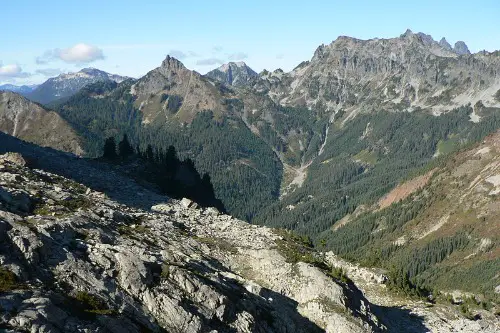
Huckleberry Trail in Glacier National Park is not for the faint of heart, mainly due to its high bear activity. Grizzly encounters are a serious concern, and hikers are advised to carry bear spray and travel in groups. Beyond the wildlife risks, the trail itself is steep and often overgrown, making navigation challenging.
The remote nature of this trail means that help is not readily available in case of emergencies. Hikers also face the risk of extreme weather, with sudden storms and freezing temperatures being common even in summer. Despite its name, this trail offers more than just huckleberries—it’s a test of preparedness and resilience.
11. Capitol Peak, Colorado
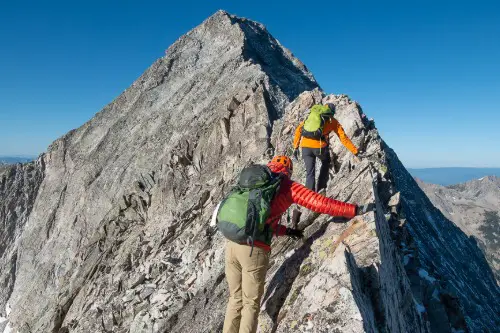
Capitol Peak is one of Colorado’s most dangerous 14ers (peaks over 14,000 feet), with a reputation that strikes fear into even experienced climbers. The knife-edge ridge, a narrow section with sheer drops on both sides, is the trail’s most infamous feature. One misstep here can be fatal, and the peak’s technical climbing sections add to the difficulty.
Altitude sickness is another concern, as Capitol Peak’s elevation poses a challenge for those not acclimated. The weather can change rapidly, with afternoon storms bringing lightning and icy conditions. Rescues are difficult and often dangerous, making this peak a true test of skill and nerve.
12. Mount Hood, Oregon
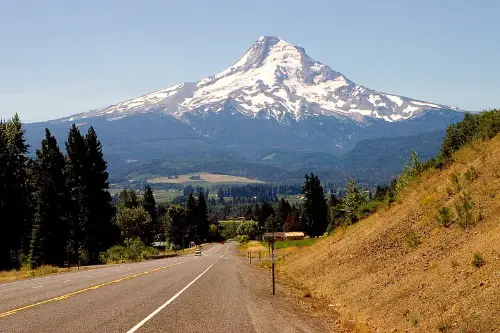
Mount Hood might look serene from a distance, but its trails can be treacherous. The mountain’s climbing routes are especially hazardous, with crevasses, avalanches, and falling ice posing significant risks. Even non-technical trails on Mount Hood can be dangerous due to rapidly changing weather and slippery terrain.
The summit attracts climbers year-round, but winter conditions are particularly deadly. Poor visibility and extreme cold have contributed to numerous fatalities. Rescue efforts on Mount Hood are notoriously difficult, often putting rescuers themselves in danger. This iconic mountain demands respect and preparation, no matter the season.


